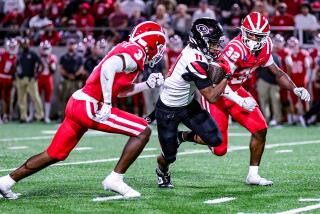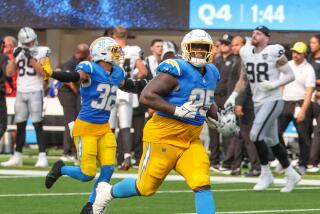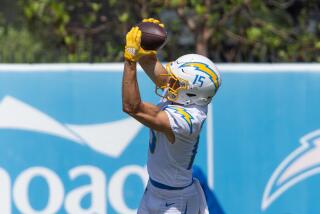Size Does Matter
- Share via
There are the four-lane wide bodies like Ted Washington. And the perfectly sculptured Adonis types, such as Jonathan Ogden.
Don’t forget the guys who can block the view of an entire backfield, like Korey Stringer. Or the ones who can tackle an entire backfield, such as Gilbert Brown.
The NFL has discovered the benefits of beef, the profit in poundage, as never before. There were 250 players who weighed at least 300 pounds on opening-day rosters. Stringer was the heaviest at 359, but the Vikings don’t measure up to the Raiders, with 13 300-pounders, or the Giants and Packers with 12 each.
Why the trend toward the colossus?
“Because everybody else does it,” says Bear Coach Dave Wannstedt, who has nine 300-pounders. “I mean that. I’ve never been a ‘big person’ type of coach. I’ve always said quickness and finesse first.
“Guys have gotten so big in the last couple of years that if you don’t have a couple of 300-pounders to match up with them, you can’t hold up for 60 minutes.”
And you can’t handle the crashes in the trenches.
“Instead of a fender-bender between a couple of station wagons, it’s like two freight trains colliding, because they’re so big,” says Lions trainer Kent Falb, who has four 300-pounders to look after.
NFL teams have always looked for man-mountains to clog the middle on defense, protect the quarterback or open running holes on offense. But never has size seemed to matter so much.
“I’m sure the defensive coaches were looking and seeing that you had 300-, 325-pound offensive linemen, and asking how’s the 275-pound defensive linemen going to hold up to them in a game?” says 300-pound guard Jeff Dallenbach of Green Bay, a 13-year veteran who played at 282 early in his career. “So they started getting bigger defensive linemen. And then when defensive linemen got a little bigger, the offensive coaches were saying, ‘Well, we can’t move this 320-pound guy, we need bigger, stronger guys.’ I think that’s been kind of the general trend.”
Bear defensive lineman Shawn Lee also began his NFL days under 300 pounds.
“There was a time I never thought I’d be 300,” Lee says. “It was a joke to me. Then, one day I looked down at the scale and I saw 300 and it kind of scared me, because I remembered one time I laughed at it. You’d see someone on TV and this guy’s 300 and it was like ‘Whoa!’ And now I’m 300. Now 320, now 330.
“It’s something you get used to.”
Fans are used to seeing the Browns--Green Bay defensive tackle Gilbert and Baltimore offensive tackle Orlando--and Nate Newton and Stringer, who seem more prepared for sumo wrestling than tackling a Terrell Davis or blocking for an Emmitt Smith. They figure girth is good, or why else would the Jaguars, Ravens, Giants, Chiefs and Cowboys be able to field entire offensive lines of players with such stratospheric weights?
“It’s a new era,” says Panthers guard Corbin Lacina, who’s about 312 pounds. “The 265-pound, 270-pound lineman used to be a big guy. Now 300 pounds is nothing. You keep seeing bigger bodies and better athletes, and that’s what the game is becoming.”
That doesn’t mean the game is becoming any better, according to quite a few players and coaches who aren’t crazy about the trend.
“Sometimes I think they might be too impressed with the size and specification of a player, instead of what he gets done on the field,” says Dolphins guard Kevin Donnalley (305), considered one of the keys to Miami’s conversion to a ground force. “When I first got in the league in ‘91, 300-pounders were about the biggest guys you saw.”
But Donnalley concedes the added weight for some guys doesn’t mean a reduction in skill or stamina nowadays.
“There are still a few of those in the game, but now you see guys who can play every down and be 320 and still do just as well in the fourth quarter as in the first.”
One reason they can last is weight-training. The added poundage is muscular, not potbellied. Another is diet: While Tony Boselli (329), Jacksonville’s All-Pro tackle, and Jags guard Ben Coleman (328) represent fast-food chains, they don’t sample the fare very often.
For all of the concerns with size, though, many NFL linemen prefer to face the 300-pounders instead of the lightning-quick variety.
Says Falcon defensive end Chuck Smith, a relative lightweight at 265:
“That stuff is overrated in this game. It’s very overrated. Look at the teams with the truly dominant defensive guys: Kevin Greene, John Randle, Bryant Young. Those are the guys who really dominated the game over last four-five years. . . . Everybody is not 330 pounds.
“It all has to do with leverage and aggressiveness. Look at Denver [with only two 300-pounders] last year.
“Green Bay had Gilbert Brown, Reggie [White], and Denver had all these castaways and medium-size guys. But they destroyed people last year.”
Dana Stubblefield (315) made a habit of destroying blockers last season, when he was the NFL Defensive Player of the Year.
Then he made a killing as a free agent, moving from San Francisco to Washington.
Stubblefield doesn’t consider himself among the big boys, perhaps because he’s not close to being the Redskins’ heaviest player.
“When you see these big guys--these huge guys--they look intimidating,” he says. “But when you play against them, you’re like, ‘Wow! Built like Tarzan, plays like Jane.’ ”
More to Read
Go beyond the scoreboard
Get the latest on L.A.'s teams in the daily Sports Report newsletter.
You may occasionally receive promotional content from the Los Angeles Times.










